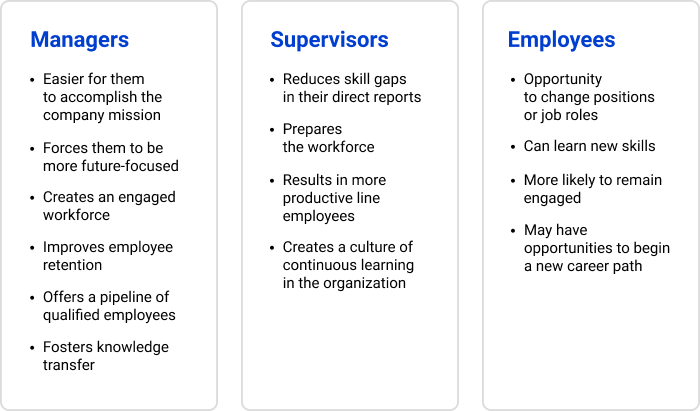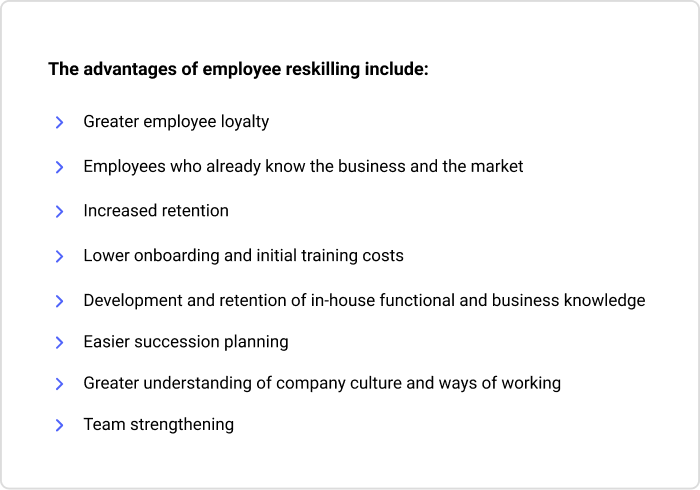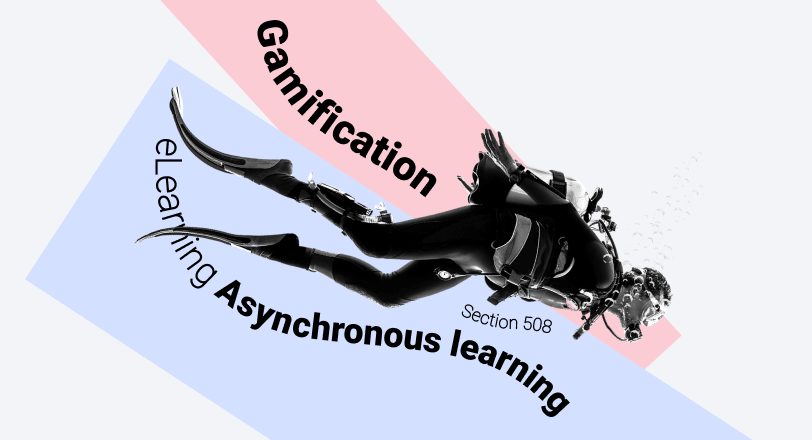Reskilling Your Workforce: The Biggest Trend in Recruiting

It may sound dramatic, but saying that the world is facing a reskilling emergency is not an overstatement. According to the OECD, it is likely that over 1 billion jobs, which represents almost one-third of all jobs worldwide, are likely to be transformed before 2030.
This transformation can result in some job positions becoming unnecessary, and new ones being created. This means that some of the positions your employees currently fill may need to be eliminated, which leaves you with the double challenge of what to do with those employees and how to fill the new positions.
The solution might be reskilling.
What Reskilling Is and Why You May Need to Use It
Reskilling means training a current employee for a new position or retraining them in the skills needed by modern business.
There are a number of cases when this could be an effective strategy.
- Employees’ current skills are losing relevance: If you have talented employees working for you but their area of expertise is becoming less relevant, it’s a bad idea to simply wait for them to become obsolete and then have to hire new staff instead. Rather, it is much better to retrain them so you can put their talent to good use elsewhere in the company.
Also read: Remote Employee Onboarding
The skills that are becoming redundant will vary depending on the industry, but, as an overall trend, automation is making the natural cycle of skills becoming outdated far more rapid than it was previously. For example, certain jobs – such as truck drivers and assembly-line workers – will soon be performed by machines, so the “living” workers will need to change their occupational categories and learn new skills to remain part of the workforce.
- Newer skills are needed for a role: The employee’s current skill set might be fine, but the position itself requires a new additional set of skills to address a change in industry practices, legislation, and working methods. For example, during the COVID-19 crisis, some pharmaceutical companies had to switch from an offline model to remote work. That’s why sales reps had to learn how to connect with clients, make the product presentations, and close deals online. In the post-pandemic era, many organizations plan to maintain this model to some degree. To meet this challenge, companies need to create a talent strategy that will help them effectively reskill their sales reps.
Also Read: Upskilling Employees: Definition, Examples, and Best Practices
Who Is a Good Candidate for Reskilling?
In addition to having a good use case for reskilling, you should also make informed decisions about which staff members you want to reskill and their personal qualities, as this will impact their suitability for a retraining program. Some traits that can make employees stand out as suitable candidates include:
- Self-starters. You probably already have employees that seem to go out of their way to learn new skills and set and achieve goals that propel the company forward. Clearly, these are the staff that you want to hold on to. By offering reskilling, you can harness that motivation and help them grow.
- Employees who manage time well. It’s also critical for students in reskilling programs to be able to balance the demands of learning new skills with day-to-day responsibilities. These could be individuals who reply to emails promptly, keep a clear list of action items, and understand how to delegate tasks to colleagues.
Benefits of Reskilling
There are numerous benefits to be gained from reskilling a workforce, both for the company and for the employees. Of course, there is some crossover here, as what benefits the company will assist the employees and vice versa, but it’s helpful to break down the advantages so we can get a clearer picture.
Employee benefits
Let’s organize the benefits of reskilling according to the different types of employees.

So, it’s clear that reskilling benefits not only top-level employees, but workers at all levels in the organization. In fact, it might be the case that retraining provides the most perks to lower-level employees in the general workforce.
Organizational benefits

For example, the coronavirus pandemic has sped up the trend toward online e-commerce over brick-and-mortar sales. What this means in real terms is that on-site retail staff may see their skills become redundant and will need to be reskilled for working with e-commerce channels, online customer service, and other related skills. Employers that started doing this immediately will be at a distinct advantage compared to those who waited.
Also read:
Reskilling Methods
There are many different employee training methods that can be used in a reskilling program.
1. Industry courses and qualifications
Industry courses, qualifications, and certifications are a straightforward way to both gain and demonstrate knowledge and skills. This makes them an ideal candidate to be part of a reskilling program.
For the employer, there are a number of benefits as they can be assured that their staff members are being retrained with knowledge specific to the industry, and that applicable professional standards are used. For the employee, it enhances their knowledge of the industry they work in and provides a qualification that feels worthwhile and substantial.
When choosing off-the-shelf or third-party industry certification courses, due diligence should be conducted to ensure the value of the certification and that it is accredited by the proper industry bodies, if required. You could, for instance, buy some ready-made courses from online learning platforms such as LinkedIn Learning or Skillshare, which have an impressive list of courses from top providers.
2. Mentoring/coaching
When you identify staff members that require reskilling, you can consider assigning a mentor or coach and building a specific targeted reskilling program.
A workplace mentoring program typically involves collaboration with the employee to identify, target, and plan for better performance, or the development of a specific set of work-related skills. Increasingly, this collaboration may happen online or virtually. A coach can help define what skills the employees have and lack, and that person’s strengths and weaknesses.
Coaching/mentoring is especially effective in reskilling employees for a move to a different role where they can benefit from the mentor’s expertise. For example, a customer service rep could be retrained to become a marketing assistant with the help of a coach who has great marketing experience.
3. On-the-job training
On-the-job training is a way that employees can learn a job by observing others performing everyday job tasks and then doing it themselves. This method is often employed when new hires go into a job role; however, it can also be used effectively as part of an internal job move, whether that be a lateral move, a planned rotation, or a professional internship program.
In practice, this means that an employee who is new to a job role is matched up with an experienced colleague or team leader; then the trainee accompanies their co-worker to observe and learn the tasks completed during a typical workday. The trainee is then allowed to perform a specific job or task they have observed and learns each task incrementally.
On-the-job training can be ideal for reskilling employees on new production methods, such as building different types of products on an assembly line.
4. eLearning
eLearning has some compelling benefits beyond of the obvious ability to reskill employees remotely. It is available any time, any place, and courses can be taken by an employee using almost any device – including personal smartphones. Online training is also quick to complete compared to instructor-led training and can be consumed over multiple sessions.
So, even when things eventually revert to what we consider ‘normal,’ eLearning can be a large part of your reskilling program and is well suited for delivering various types of training, including digital skills, soft skills, and business skills.
Great examples of ways to perform retraining online that can add real value are software simulations that reskill employees on new software systems or financial compliance courses for reskilling service staff to take on roles as financial advisors.
5. Blended learning
Blended learning uses two or more training methods combined to achieve the desired reskilling outcome. For instance, this could be a mix of on-the-job training supported by prerequisite digital learning modules.
Blended learning is considered to be a particularly effective approach to reskilling, as it offers all the benefits of both traditional synchronous methods and eLearning. This could be particularly useful in a reskilling scenario, such as the case where complex concepts are trained by a qualified instructor and general training for the new role is provided through microlearning.
Also read: → Most Effective Types of Employee Training
Steps to Reskill the Workforce with eLearning
As mentioned above, eLearning is now one of the most widely used and suitable formats for retraining. Here’s how you can set up a reskilling program with eLearning using industry best practices.
Step 1. Identify the skills that should be mastered
The first step in reskilling is performing a training needs analysis and identifying which skills are outdated and should be replaced by retraining.
Let’s take the following example: a company may define that its projected need for software developers will not be met by current staff; however, they do have employees in other roles, like IT support staff, who probably have the ability to successfully learn that skill set. These employees are already familiar with some of the technologies involved and with the company’s business processes, so they’re in a great position to advance their careers with reskilling.
Step 2. Prepare a training program
In this step, you should identify how each skill that needs to be trained should be delivered, the specific learning objectives, and how it will be assessed.
For example, to reskill our IT support staff as a software developer, the training program would include eLearning modules covering basic concepts of software engineering, general programming theory, plus modules on specific programming languages used by the organization, like PHP or Python.
Step 3. Prepare training materials
Of course, you can buy existing off-the-shelf courses – they will allow you to start training right out of the gate. However, if you need organization-specific courses and don’t want to contract a third-party vendor to develop the learning content, creating courses in-house is your best bet.
Whichever subjects you want to train, you will need a competent authoring tool to create courses. Rapid eLearning tools, such as iSpring Suite, are ideal for creating reskilling training with interactive elements, quizzes, and assessments that really engage employees – and the training program can be put together in a matter of hours.
Continuing with the sample position we looked at above, our eLearning course could include training that makes use of code snippet examples followed by interactive simulation of the output.
Step 4. Deliver the reskilling program
When you have finished creating your course, you’ll need some way to publish and share it with employees. Many organizations will prefer to deliver training via a learning management system (LMS), as it provides specific benefits for reskilling programs.
For example, iSpring Learn LMS allows you to create learning tracks that are pathways for obtaining the skills applicable to different roles and resume courses, modules, and lessons to build these. You can also configure it to issue certificates to your employees after they complete a course or an entire program.
A key benefit of an LMS for reskilling is its ability to automate the training processes. This means automatic course enrollment, automatic deadline setting, and the sending out of notifications and reminders. This will save you a lot of time and administration work when dealing with larger programs.
Step 5. Measure and evaluate success
There is no point creating and running a great reskilling program if you don’t track how effective it is. Fortunately, this is easily achieved with an LMS.
There are several standard LMS metrics, like quiz pass rates, learner progress, and course completion rates, that will help you know if your audience is getting the most out of their reskilling experience
By using the metrics from your chosen LMS, in combination with employee feedback and evaluations, you can also begin to measure how good your program is and implement processes that will continuously improve your reskilling training.
Also read: 17 Key Recruiting Metrics and How to Improve Them with Online Training
Final Thoughts
Reskilling offers many benefits for an organization and allows you to retain and make use of loyal employees in the best way possible. It will be an essential building block of any Learning & Development strategy for the new decade, so now is the time to begin thinking about how you will implement such a program for your own workforce.










